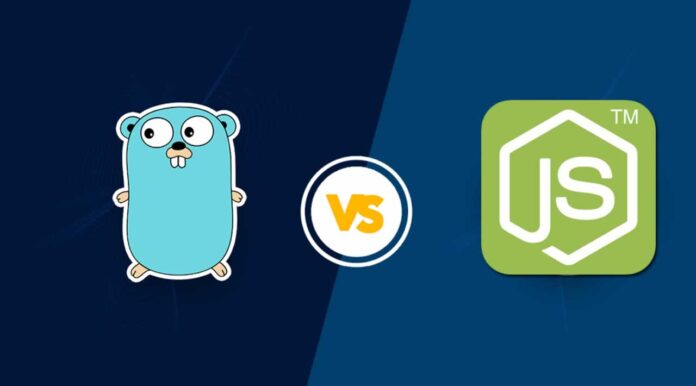In the world of backend development, choosing the right technology can make a significant difference in performance, scalability, and ease of development. Two of the most popular backend technologies today are Go (also known as Golang) and Node.js. Both are powerful, widely used, and supported by active communities, but they have unique strengths and weaknesses that suit different use cases.
In this comprehensive guide, we’ll dive into the key differences between Go and Node.js, explore their performance, scalability, learning curve, and ecosystems, and help you make an informed decision on which technology is better suited for your next backend project.
Table of Contents
- What is Go?
- What is Node.js?
- Go vs. Node.js: A High-Level Overview
- Performance Comparison
- Concurrency and Scalability
- Development Experience and Learning Curve
- Ecosystem and Libraries
- Use Cases: When to Choose Go or Node.js
- Community and Job Market
- Conclusion
1. What is Go?
Go, or Golang, is an open-source programming language developed by Google in 2009. It was designed by Robert Griesemer, Rob Pike, and Ken Thompson to address common challenges in large-scale systems development, such as slow compilation, inefficient memory usage, and difficult concurrency management. Go is statically typed, compiled, and known for its simplicity, speed, and built-in support for concurrency through goroutines.
Go has gained immense popularity in industries that prioritize performance, such as cloud computing, distributed systems, and microservices. It is used by companies like Google, Uber, Dropbox, and Kubernetes because of its high performance, low memory footprint, and excellent scalability.
Key Features of Go:
- Compiled language: Go compiles directly to machine code, resulting in fast execution times.
- Concurrency model: Go uses goroutines and channels to manage concurrent tasks efficiently.
- Minimalist syntax: Go’s syntax is designed to be simple and easy to learn, reducing complexity.
- Strong standard library: Go comes with a robust set of built-in libraries for handling I/O, web servers, concurrency, and more.
- Garbage collection: Go provides automatic memory management, allowing developers to focus on writing code rather than manual memory allocation.
2. What is Node.js?
Node.js is a JavaScript runtime built on Chrome’s V8 engine, released in 2009 by Ryan Dahl. It allows developers to use JavaScript for building backend services, which was previously limited to front-end web development. With Node.js, developers can write server-side code in JavaScript, creating full-stack JavaScript applications where both frontend and backend share the same language.
Node.js has gained popularity for its non-blocking, event-driven architecture, which makes it ideal for handling I/O-bound operations, such as APIs, real-time applications, and microservices. It’s widely used in the web development industry, with large companies like Netflix, PayPal, LinkedIn, and Uber relying on Node.js for high-performance, real-time services.
Key Features of Node.js:
- JavaScript on the backend: Node.js allows developers to use the same language (JavaScript) for both client-side and server-side development.
- Non-blocking I/O: Node.js uses an event-driven, non-blocking I/O model, making it efficient for handling asynchronous operations.
- Vast ecosystem: Node.js has a rich ecosystem of open-source libraries and modules via npm (Node Package Manager).
- Scalability: Node.js is designed to scale efficiently for I/O-heavy tasks, such as serving APIs or handling many connections at once.
- Cross-platform: Node.js runs on Windows, macOS, and Linux, making it highly versatile for developers.
3. Go vs. Node.js: A High-Level Overview
At first glance, Go and Node.js appear to be suited for similar backend tasks, such as building APIs, handling web servers, and managing large-scale applications. However, the underlying differences in how they operate—Go being a compiled language with a focus on concurrency, and Node.js being an interpreted runtime for JavaScript with an event-driven architecture—lead to significant distinctions in performance, scalability, and use cases.
Here’s a quick comparison:
| Feature | Go | Node.js |
|---|---|---|
| Language | Go (Golang) | JavaScript |
| Type System | Statically typed, compiled | Dynamically typed, interpreted |
| Concurrency Model | Goroutines and channels | Event loop and asynchronous callbacks/promises |
| Performance | High performance, low memory usage | High for I/O tasks, slower for CPU-bound tasks |
| Scalability | Excellent for CPU-bound tasks and large-scale systems | Great for I/O-bound and real-time applications |
| Learning Curve | Moderate (new language) | Easy (JavaScript familiarity) |
| Ecosystem | Smaller but growing | Large with npm (over 1.5 million packages) |
| Best Suited For | High-performance, CPU-intensive applications | Real-time, I/O-heavy applications (e.g., chat apps, APIs) |

4. Performance Comparison
When it comes to performance, Go and Node.js have clear distinctions due to their underlying architecture and design.
Go:
Go is known for its high performance, largely because it’s a compiled language. Since Go compiles directly to machine code, applications written in Go run incredibly fast, comparable to languages like C and C++. Additionally, Go’s lightweight goroutines make concurrent programming highly efficient. Go is especially performant in CPU-bound tasks, such as processing large datasets, real-time data analysis, or running computationally heavy algorithms.
The garbage collection in Go is also highly optimized, ensuring that memory is managed efficiently without negatively impacting performance. In scenarios where raw speed and performance are required, such as high-throughput systems, distributed microservices, or complex backend systems, Go shines.
Node.js:
Node.js, while highly performant for certain tasks, is an interpreted runtime, which means it’s generally slower than compiled languages like Go when it comes to CPU-intensive tasks. However, Node.js excels in I/O-bound tasks due to its non-blocking, asynchronous architecture. It handles multiple requests without blocking the event loop, making it perfect for applications that rely heavily on API requests, file handling, or real-time updates.
In scenarios such as handling web requests, serving static content, or managing websocket connections, Node.js can be incredibly efficient, but it can struggle with tasks that require significant CPU power, such as video encoding, machine learning computations, or other heavy computational tasks.
Verdict:
- Go: Ideal for CPU-bound tasks and applications where performance and memory management are critical.
- Node.js: Great for I/O-bound tasks, real-time applications, and systems where handling many simultaneous connections is a priority.
5. Concurrency and Scalability
Concurrency and scalability are critical factors when building modern backend systems. Both Go and Node.js have strong concurrency models but approach it differently.
Go:
Concurrency in Go is built into the language itself through goroutines. Goroutines are lightweight, independent threads managed by the Go runtime. Unlike traditional threads, which can be resource-intensive, goroutines are designed to be lightweight, allowing Go applications to efficiently handle thousands or even millions of concurrent tasks.
Goroutines communicate through channels, a core feature in Go that facilitates safe data exchange between concurrent tasks without the need for complex locking mechanisms. This makes Go an excellent choice for CPU-bound, parallel tasks, such as building high-performance web servers, microservices, or distributed systems that require efficient handling of concurrent operations.
Node.js:
Node.js uses a single-threaded event loop to handle concurrency. This event-driven model allows Node.js to manage multiple I/O operations concurrently without creating additional threads. Instead of using threads to handle tasks, Node.js employs callbacks or promises to manage asynchronous operations like file I/O, database queries, and network requests.
While Node.js is highly efficient for I/O-bound operations, it can struggle with CPU-bound tasks due to its single-threaded nature. However, Node.js can scale horizontally across multiple processes or servers using tools like PM2 or worker threads, allowing it to handle significant loads.
Verdict:
- Go: Better for CPU-bound tasks and parallelism, with native concurrency through goroutines.
- Node.js: Excellent for I/O-bound tasks and asynchronous operations, with built-in event-driven architecture.
6. Development Experience and Learning Curve
The development experience and learning curve are important considerations, especially when deciding which technology to adopt for a project or team.
Go:
Go has a simple, minimalistic syntax that is easy to read and write. It was designed to reduce complexity, so developers can quickly learn and start coding. However, since Go is a new language for many, there is still a learning curve, particularly if you’re coming from dynamically typed languages like JavaScript or Python.
One of Go’s standout features is its built-in tooling, including go fmt (for formatting code), go test (for running tests), and go build (for compiling code). These tools are highly standardized, reducing the need to learn many third-party libraries or tools. However, Go’s static typing and lack of advanced features like generics (until Go 1.18) can sometimes feel limiting.
Node
.js:
Node.js benefits from the widespread knowledge of JavaScript, one of the most popular programming languages in the world. For developers who already know JavaScript, picking up Node.js is relatively straightforward, making the learning curve much gentler compared to Go.
The JavaScript ecosystem is vast, and with npm, developers have access to an enormous number of libraries and tools. However, the freedom and flexibility of JavaScript can sometimes lead to complexity, especially when dealing with asynchronous code, callbacks, or promises. Modern features like async/await have improved the development experience, making it easier to manage asynchronous operations.
Verdict:
- Go: Simple, but with a moderate learning curve due to its static typing and being a new language for many developers.
- Node.js: Easier to learn for developers familiar with JavaScript, but can be complex due to asynchronous programming patterns.
7. Ecosystem and Libraries
The strength of an ecosystem plays a big role in a technology’s ability to quickly build and scale applications. Both Go and Node.js have active ecosystems, but they differ in size and maturity.
Go:
Go’s ecosystem is growing rapidly, but it is still smaller compared to Node.js. The official Go standard library is one of its biggest strengths, providing developers with a robust set of tools for common tasks, such as handling HTTP requests, concurrency, cryptography, and I/O. For more specific use cases, there are plenty of third-party libraries available through Go’s package manager, go mod.
While Go’s ecosystem is smaller, it is generally seen as more stable and secure, with strict coding standards and high-quality libraries. The Go community has a strong focus on building reliable, production-ready applications, which is why it’s often chosen for critical infrastructure projects.
Node.js:
Node.js has one of the largest ecosystems of any technology, thanks to npm (Node Package Manager), which hosts over 1.5 million packages. This makes it incredibly easy to find libraries for almost any use case, from web frameworks (like Express) to database connectors (like Mongoose for MongoDB).
While the size of Node.js’s ecosystem is impressive, the quality of npm packages can vary widely. Developers need to be cautious about choosing packages with active maintenance and strong security practices. The sheer number of options available for Node.js can sometimes lead to “decision fatigue,” where it’s hard to choose the best solution for a given problem.
Verdict:
- Go: Smaller but more stable ecosystem, with a strong emphasis on quality and performance.
- Node.js: Huge ecosystem with npm, offering a package for nearly any task, but quality can vary.

8. Use Cases: When to Choose Go or Node.js
Both Go and Node.js are versatile, but they shine in different use cases depending on the requirements of your project.
When to Choose Go:
- High-Performance Systems: If you need raw performance, such as building a low-latency API, real-time data processing, or high-throughput services, Go’s compiled nature and concurrency model make it the better choice.
- Microservices: Go is ideal for building scalable, lightweight microservices due to its efficient memory management and support for parallel tasks.
- Cloud-Native Applications: Go is the language of choice for many cloud-native platforms and tools (like Docker and Kubernetes) due to its simplicity and performance in distributed systems.
When to Choose Node.js:
- Real-Time Applications: If you’re building a real-time chat application, collaborative tool, or any service that requires handling many connections at once, Node.js’s non-blocking I/O and event-driven architecture make it a great fit.
- Full-Stack JavaScript Development: If you want to use the same language (JavaScript) for both the frontend and backend, Node.js is the obvious choice. This allows for code reuse and streamlines development.
- APIs and Microservices: Node.js is widely used for building RESTful APIs and microservices, especially for I/O-heavy tasks that require handling many network requests simultaneously.
9. Community and Job Market
Both Go and Node.js have strong communities, but they differ in size and maturity.
Go:
Go’s community is growing rapidly, and it has a strong presence in the cloud infrastructure and DevOps space, where performance and scalability are critical. Go’s job market is expanding, especially in industries like cloud computing, enterprise software, and backend development. With tools like Kubernetes, Docker, and Prometheus built in Go, there is a high demand for Go developers in cloud-native projects.
Node.js:
Node.js has a massive community, driven by the popularity of JavaScript. There is a wealth of resources, tutorials, and tools available for Node.js developers, and the job market is strong due to the demand for full-stack developers who can work on both the frontend and backend. Node.js is particularly popular in startups and web-focused industries where real-time applications and APIs are crucial.
Verdict:
- Go: Growing community with a focus on performance-driven applications, especially in cloud and enterprise environments.
- Node.js: Larger community with widespread usage in web development, startups, and full-stack development.
10. Conclusion
Choosing between Go and Node.js depends largely on your project’s specific needs and your team’s expertise. Go excels in high-performance, CPU-bound applications and large-scale systems that require efficient concurrency and low-latency processing. It’s a fantastic choice for microservices, cloud infrastructure, and applications where speed and memory efficiency are paramount.
On the other hand, Node.js shines in I/O-heavy, real-time applications such as chat services, APIs, and streaming platforms. Its ability to handle many concurrent connections with non-blocking I/O makes it perfect for projects where performance is measured by how well the system manages network requests.
If you’re building a cloud-native microservice or backend system that needs to handle heavy computation, Go is likely the better choice. However, if your focus is on real-time web apps, or you’re already familiar with JavaScript, Node.js offers simplicity and ease of use.
Ultimately, both Go and Node.js are powerful tools, and the right choice will depend on the specific requirements of your project, as well as your development team’s background and goals.



